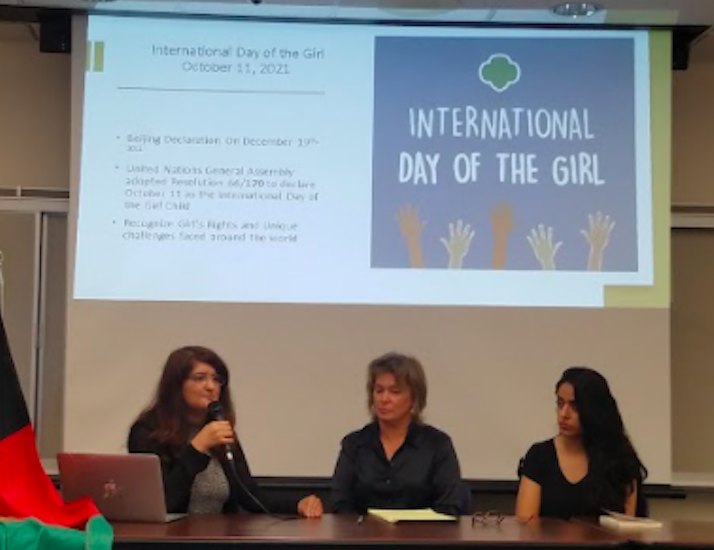Washington, DC – On the eve of the International Day of the Girl Child, Afghan Human Rights Activist and lawyer Khalida Nawabi organized Stand with Afghan Girls to raise voices in support of the girls whose rights have been taken away by the Taliban.
Speaking at the event, Nawabi said that this day was celebrated in Afghanistan last year to ensure gender equality, economic empowerment, girl’s rights, and better access to education in rural areas of Afghanistan. This year it is a black day for girls in Afghanistan. Their rights have been taken away by the Taliban who are sponsored and supported by Pakistan’s Inter-Services Intelligence (ISI). Educational institutions have been shut down, girls are not allowed to participate in any social activities, and the Women’s Affairs Ministry has been abolished.
Nawabi provided a historical overview of the rights that women have always had in Afghanistan. In 1920 Afghan women had the right to vote. In 1965, two women senators were elected to the Afghan parliament. Nawabi commented that Afghans have enjoyed democracy from the moment of their independence in 1919, but today they have no parliament, no working democracy, and no representation for women in government.
Human rights were not respected in 1996 by the Taliban, and they are not respected by them now said Nawabi. We are back in 1996. There is violence against journalists and women activists, no human rights, and no freedom of speech.
Human rights activist Mahbooba Dawar spoke of how education in Afghanistan has been devastated by three decades of civil war, but their education system was established more than a century ago with schools founded in 1903. The first high school for girls was founded in 1921, and over 800 girls attended the school in the first two years. The Ministry of Education was established in 1922 by Prince Abdur Rahman. In 1927, a curriculum was established for teaching English. Co-education in Afghanistan dates back to 1928. The first law school was founded in 1938. 1947 saw the establishment of two girl’s high schools established in Kabul, and the University of Kabul.
Afghan American student Farrah Qahar spoke of how her heart goes out to Afghan girls and women who have been deprived of their rights and freedoms by the Taliban, who are being supported and sent to Afghanistan from Pakistan. Unfortunately the world is watching and not doing anything, said Qahar, “We want everybody to open their eyes and help our people.”
The International Day of the Girl Child
In his message, UN Secretary General António Guterres said, “The strength, health and empowerment of the world’s girls is a matter for every single day of the year. The International Day of the Girl is an opportunity to recommit to this global imperative.”
Background
In 1995 at the World Conference on Women in Beijing countries unanimously adopted the Beijing Declaration and Platform for Action – the most progressive blueprint ever for advancing the rights of not only women but girls. The Beijing Declaration is the first to specifically call out girls’ rights.
On December 19, 2011, United Nations General Assembly adopted Resolution 66/170 to declare October 11 as the International Day of the Girl Child, to recognize girls’ rights and the unique challenges girls face around the world.
The International Day of the Girl Child focuses attention on the need to address the challenges girls face and to promote girls’ empowerment and the fulfillment of their human rights.
Adolescent girls have the right to a safe, educated, and healthy life, not only during these critical formative years, but also as they mature into women. If effectively supported during the adolescent years, girls have the potential to change the world – both as the empowered girls of today and as tomorrow’s workers, mothers, entrepreneurs, mentors, household heads, and political leaders. An investment in realizing the power of adolescent girls upholds their rights today and promises a more equitable and prosperous future, one in which half of humanity is an equal partner in solving the problems of climate change, political conflict, economic growth, disease prevention, and global sustainability.
Girls are breaking boundaries and barriers posed by stereotypes and exclusion, including those directed at children with disabilities and those living in marginalized communities. As entrepreneurs, innovators and initiators of global movements, girls are creating a world that is relevant for them and future generations.

Poonam Sharma
Poonam Sharma, Managing Editor, India America Today


